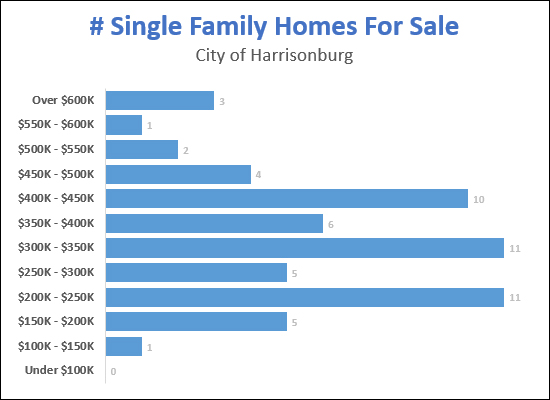Does Building College Student Housing In Harrisonburg Impact City Schools? |
|
 At first glance, the answer to this question seems obvious... If more college student housing is built in Harrisonburg, those college students are very unlikely to have children attending K-12 schools in the City of Harrisonburg. So, there is not a connection between college student housing construction and K-12 student population, right? Well... maybe there actually is an indirect connection... Using some rough, and certainly inaccurate numbers, let's pretend... [1] There are 21,000 students at JMU. [2] Of those, 7,000 students live on campus. [3] Thus, 14,000 students live off campus. And let's pretend that today, there is enough off campus college student housing for... magically... 14,000 students. Clearly, it's not this cut and dry, but I can pretend. Now, what happens when more off campus college student housing is built? What happens when there is enough new housing to fit 500, 1000 or 2000 more college students? First off, yes, JMU is growing and will continue to grow over time... but not that fast!? Now, after this new off campus college housing for 2,000 more students is constructed we will have off campus student housing for 16,000 college students... but only 14,000 college students who need housing! What seems to inevitably happen in Harrisonburg, is that when new off campus student housing is built... some of the existing (usually older) off campus student housing is no longer occupied by college students. And then, yes, the new tenants... who are not college students... may have children... who would attend City schools. So, while it may seem at first glance that building off campus college student housing does not impact the City school population (and thus the City budget to pay for educating more students) it seems that this new off campus college housing actually can indirectly impact City schools. As to the illustration above... A = More New Off Campus College Housing B = More Vacancies in Off Campus College Housing C = Off Campus College Housing Occupied By Non College Students D = More K-12 Students Attending City Schools If A=B and if B=C and if C=D... then, does A=D? A few pretty broad disclaimers... 1. I'm not saying it's a bad idea to build more off campus college housing. 2. I am saying it's a good idea to discuss and understand the primary and secondary impacts of building new off campus college housing... or any other type of housing. 3. I'm not saying it's a bad thing to have non college student rental housing created through increased vacancies at what were previously college student housing complexes. Perhaps that's a good thing... or a normal part of the housing cycle in a college town? As with most of my writing about the dynamics of our local housing market... I'm not trying to convince you that one thing or the other is a good or bad... I'm just trying to get some discussion points out there for you, and others, to consider and decide what you think. :-) | |
Can New Homes Be Built That Buyers Will Want and Can Afford? |
|
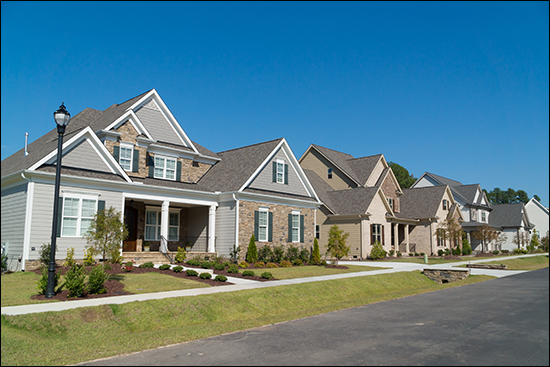 OK -- lots of great thoughts from folks over on Facebook yesterday, and in person as I talked to people around town yesterday, after I suggested that our market needs lots of mid size detached homes to be built. I'm going to think aloud about all of that by capturing a bit of that conversation here.... --- WHAT TYPES OF HOUSES? I had suggested that homes along these lines were needed for current townhouse owners that want to buy their first detached home....
These types of homes have not been built in large quantity over the past ten years, and I believe there are plenty of buyers who would love to buy this type/size of home. --- COSTS ARE HIGH BEFORE THE ACTUAL CONSTRUCTIONAs Jim, Jerry and Keith pointed out, It is expensive (!!!) to create a developed lot. The cost of building roads, installing water an sewer lines, utility hook up fees, etc. all add up to make the costs quite high even before construction (pouring the foundation, framing the home) begins. And as Nate points out -- if the land cannot be purchased by a builder at an affordable price, the rest of the equation downstream won't work out. High costs for land, plus development costs, plus building costs, will result in unrealistically high prices for homes, that then won't be affordable (or desirable at that price point) to buyers. Nate then ponders whether larger, regional builders can do better than local builders in this regard based on economies of scale. I'm not sure if the savings would be in buying a larger tract of land, lower development (infrastructure costs), or lower building costs -- but I wonder the same. Gary and Renee also point out that some of these "costs before you even start building" are high because of utility connection fees, requirements for stormwater management, proffers, etc., that are coming from government regulations and development requirements. Ginny points out that the final cost of a house is largely dependent on the initial land and development costs. Thus, to have smaller single family homes built, we may need to see smaller lots, to keep those initial costs down. --- DEMAND NEEDS TO DISCUSSED WITHIN THE CONTEXT OF PRICE As Jim succinctly puts it, "If I want something I can't afford then it isn't really demand." An excellent point -- which means that we need to think about (and talk about) the demand for the homes I outlined above (for example) within the context of the price for bringing such a home to market. If the houses I described (1750 / 1950 / 2150 square feet) were able to be sold for $150K, $175K and $200K (obviously not realistic) then clearly, there would be a ridiculously high demand for them. I believe that if the houses I described could be sold for $250K, $275K and $300K there would still be a strong demand for them. But, clearly, if the homes could not be sold for any less than (I'm exaggerating again) $400K, $425K and $450K then likely NOBODY would want want to buy them. So, yes, when we talk about demand for a particular type of housing, it likely should be -- as best as possible -- set within a context of price. That price-based demand can then be compared to development and building costs to see if developer and builders can bring such a product to market at a price that it will sell. --- WHAT SHOULD WE BE ADDING TO OUR HOUSING STOCK? As Jim also points out, the high demand and low supply environment we're in right now COULD cause a large quantity of under-qualified builders to start building homes. This doesn't help, in the long-term, as it is adding lower quality homes to our housing stock, which I do not believe helps our community in the long-term. Jim goes on to suggest that we should be ensuring that we are adding quality homes to our housing stock. I agree -- though I do think that we need to find a balance. If the quality of materials and finishes is too high, we're pricing ourselves out of the ability to meet the demand we're discussing. Michael takes us in a different direction when considering what should be built. He points out that even beyond building for all of those townhouse buyers (the original reason for my suggestion that we need to build mid sized detached homes) that he believes there is also a significant demand for affordable housing for the elderly in our community. He points out that retirement communities are not affordable for everyone, and plenty of older adults in our community would love to move into an affordable, (one-level), wheelchair accessible home. Again -- another market segment where we are not seeing much new construction. --- WHAT ARE PEOPLE GOING TO DO IF WE DON'T BUILD THESE HOMES? Ginny suggests that homeownership may be delayed for some families. A good point -- if the homes they want aren't available at the prices they can afford, perhaps they'll keep renting or keep living in the townhome they purchased. Ginny also suggests that we'll see more remodeling or upgrading of current homes to accommodate growing families, which also makes sense. Keith suggests that people will just have to move to some of the more affordable towns surrounding Harrisonburg. There are more affordable detached housing options when you look to Broadway, Timberville, Elkton and Grottoes. So, perhaps the townhome owners will just have to settle for a bit of a commute in order to buy a mid sized detached home that fits their budget. Jim suggests that maybe higher costs for new homes means that it will take much longer for families to be able to buy a home -- and perhaps they will have to stay in one home for a lifetime, instead of moving every 5 - 7 years. Gary concludes that many in our community may simply have to rent, or keep living in a townhouse, because of the cost of building new homes. --- CONCLUSIONS There were many other great points made, and discussions beginning, so thanks to all who engaged in this topic. A few big picture thoughts that come to mind for me....
Keep the conversations going, folks, on Facebook, with me, with each other. As Jim points out, "we're going to have to do housing differently than it has been built in the past 30 years if we are going to provide sustainable, affordable housing." | |
Make your voice heard in the updated Comprehensive Plan for the City of Harrisonburg |
|
 The City of Harrisonburg is in the midst of updating the Comprehensive Plan for the City. As per the City.... The Comprehensive Plan presents a vision of Harrisonburg's future. It identifies steps to move toward that vision by providing information about current conditions, long-term goals and objectives, and recommended implementation strategies. As described in the Code of Virginia, the Comprehensive Plan is general in nature. Harrisonburg's Plan addresses a wide range of issues including but not limited to: land use, housing, education, transportation, recreation, the preservation of historic and natural resources, and economic development. The plan serves as a long-term guide for the community, and it helps City leaders with setting policies and decision-making. So, basically, what do you want the City of Harrisonburg to be in 10 or 20 years? Discussions taking place and decisions being made right now will affect that future, and you have the opportunity to be a part of the conversation! Better yet -- there are several Public Workshops coming up that will allow you to chime in on topics near and dear to your heart.... Education; Arts, Culture, and Historic Resources; and Community Engagement & CollaborationSo, mark your calendars, and get involved in the discussions and decisions to help shape the future our our great City! Also of note.... Lots of Q&A's about the Comprehensive Plan update can be found here. General information about the Comprehensive Plan update can be found here. | |
How much of the City of Harrisonburg single family housing stock sells in any given year? |
|
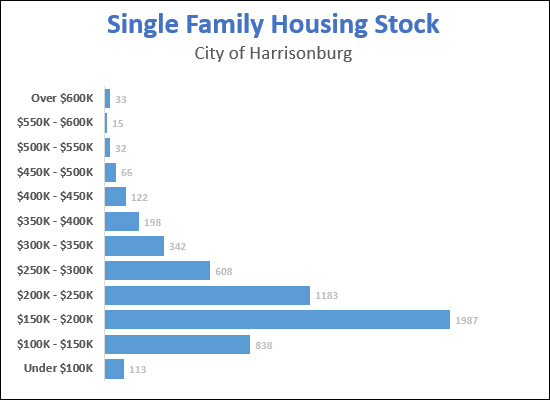 OK -- I'll point out, from the start, that I'm making things a bit more complicated here. I'll partially blame Derik, as he asked the question. OK - the graph above, is the same one I posted yesterday -- a look at how many single family homes exist in the City of Harrisonburg in a variety of price ranges, based on their assessed values. But -- if that's how many actually exist -- it is probably reasonable to wonder how many homes actually sell in each of those price ranges in each year. So, here are the City single family home sales in the same price ranges for all of 2016.... 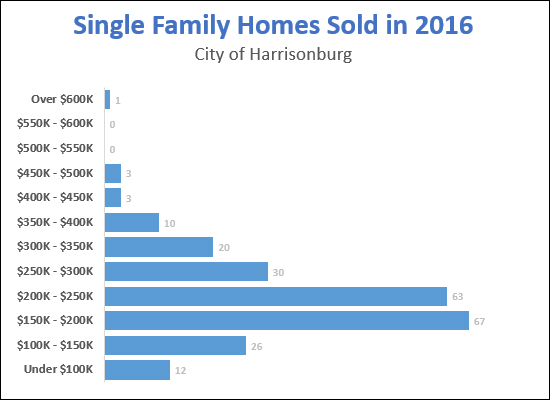 You'll notice that the two graphs above don't look altogether that different. Then, to combine these two, rather than just put really little numbers (how many sell) next to really big numbers (how many physically exist) I thought I"d look at what percentage of each price segment of the City housing stock sells in a given year....  I think this makes it more helpful, though slightly less specifically meaningful absent scrolling back up and also remembering how many houses we're talking about in each given price range. For example, the chart directly above shows that:
OK -- next, a few flaws and disclaimers:
OK -- it continues -- I think it is probably necessary to try to contextualize this with "active listing" data -- to see how some of these numbers compare to what is available today for a buyer to purchase. Here is a breakdown of single family homes currently for sale....
As you can see, above, there are NOT a lot of homes for sale in the City of Harrisonburg right now. And let's see if we can flesh anything out if we break it down by how many homes are available to be purchased as compared to the overall number of homes that actually exist....
This graph might have been the one I was looking for -- at least to support my understanding of the world.... Right now -- almost 9% of the homes over $600K are listed for sale -- and 6% to 8% of homes over $400K are listed for sale in the City of Harrisonburg. On the other hand, only 3% of homes between $300K and $400K are listed for sale, only 1% of homes between $200K and $300K and less than 1% of homes under $200K are listed for sale. This would seem to be about as clear of an indicator as one could find that homes under $300K (or even better, under $200K) are in short supply and in high demand in the City of Harrisonburg. Finally, lastly, ultimately, some "overall market" stats....
Questions? Thoughts? Observations? Insights? Suggestions? Email me: scott@HarrisonburgHousingToday.com | |
Single Family Housing Stock in the City of Harrisonburg |
|
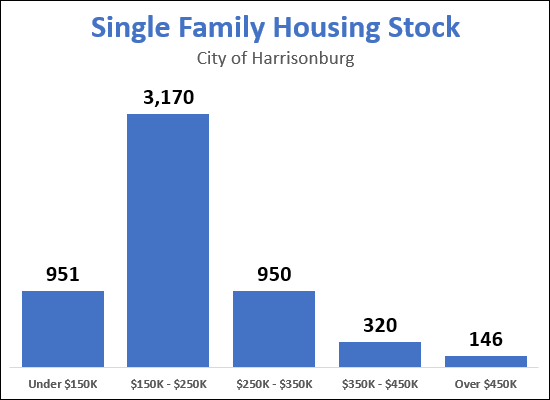 Forget about what actually SELLS in any given timeframe, or even what is available FOR SALE at any given point in time. Let's get down to what housing actually EXISTS in the City of Harrisonburg. The graph above shows the number of single family detached homes (Use Code 006 in the City's property database) that exist in the City of Harrisonburg in five different price ranges. The homes are sorted into these price categories based on their 2017 assessed values. So -- what surprises you? If more single family homes are to be built in the City, what price range should they fit into? | |
Harrisonburg could never have enough student housing! |
|
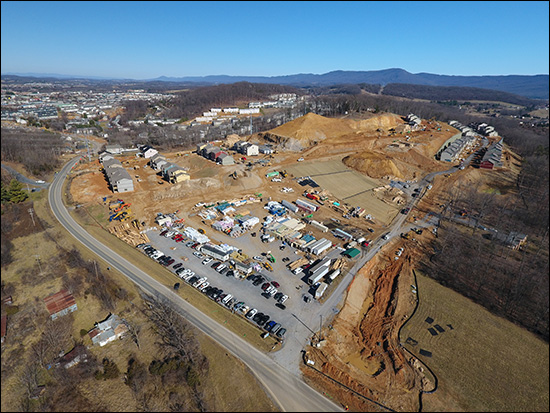 OK, OK, that's probably not true -- Harrisonburg probably does not have an infinite need for student housing. Just consider my title, then, to be an intro to all of the alternative perspectives that have been shared with me since I wrote these two posts.... Does Harrisonburg need more Off Campus Student Housing? Does New College Student Housing Increase the Demands on Local Elementary Schools? OK -- here goes -- all the reasons I might be wrong, and all of this new student housing might be OK, or even a good thing.... 1. JMU is growing! All of this student housing is necessary -- JMU is continuing to grow, and they are not building on campus fast enough for their growth, so the private sector must build and rent housing to students in order to meet that growing demand. 2. Denying growth just pushes it elsewhere. If the City decided to stop permitting new student housing communities to be built, that would just push developers to build them in the County, or push students to live in otherwise owner occupied neighborhoods. 3. This is an affordable way to get workforce housing. There isn't much truly affordable rental housing being built -- and older student housing complexes being effectively turned into workforce housing by virtue of students being attracted to new student housing communities is not necessarily a bad thing. It may be the most affordable way to create affordable or workforce housing. 4. Bring on the wrecking ball. If even more student housing is built, the rental rates will fall even lower on the oldest complexes, devaluing those properties to the point where it will make sense to just knock them down and build new housing -- thus, eliminating the older, outdated housing. 5. How much regulation do you want "the government" to do? If the government (planning commission, city council, staff) should start making judgement calls about how much student housing is too much student -- and thus regulating what landowners (and student housing developers) can and cannot do -- should they also start governing other segments of the private sector? Should they regulate how many hair salons exist? How many banks are permitted to operate? How many restaurants can open? How many Realtors can sell homes? :) OK -- again -- I don't necessarily agree with all of the perspectives above, but I believe it is important to consider these counterpoints when thinking about how our community should be planning for the future as it pertains to student housing, land use, property taxes, schools, etc. And, as I mentioned to a reader in response to their comments.... I don't know if new student housing projects should or should not be denied - but I think the local community needs to fully understand the impact of continuing to approve more student housing communities. If older student housing communities become workforce housing, great, no problem -- but let's realize that this is the result of approving new student housing communities, and make sure that infrastructure (schools, for example) are in place for the new workforce housing that we have indirectly created. | |
Does New College Student Housing Increase the Demands on Local Elementary Schools? |
|
 Traditional logic would say no -- the construction of new college student housing in Harrisonburg won't increase the load on elementary schools, as most college students do not have elementary school aged children.... Going a step further, I would guess that some local government staff and elected officials MIGHT (?) use this traditional logic when thinking about whether to approve rezonings, or other approvals, for new student housing to be built in the Harrisonburg area. But wait - what if the following sequence happens (thanks Deb, with some revisions)....
I think we have seen this happen over the past 20 years in Harrisonburg, in cycles, as large quantities of student housing is built in waves. And think about it, from the other direction, for a moment -- we all know that the local elementary school population is growing -- but why, and where? It's not as if local developers and builders are out building an extraordinary number of townhomes or starter homes for young families, causing an influx of new elementary school students. So -- if the elementary school population is rising, and it's not because of an increase in the stock of owner occupied real estate in Harrisonburg, then.... 1. Perhaps this elementary (or K-12, really) school enrollment growth is, contrary to what we'd otherwise believe, a direct result of an increase in college student housing. 2. Perhaps we need to think about the fiscal impact of educating more elementary (and then middle and high) school students when we think about approving yet another student housing complex. 3. Perhaps, if building new student housing when we might not really need it, leads to increased demands on our local K-12 schools, then maybe we need to pay more attention to whether that student housing is needed. Just some thoughts to ponder as we think about and plan for the future here in the City of Harrisonburg -- and Rockingham County. | |
Grace Street Project Community Design Charrette |
|
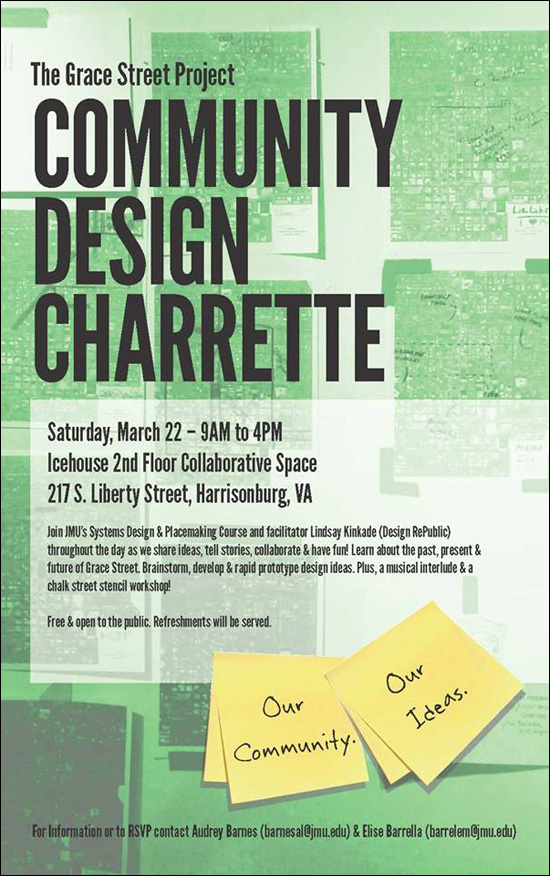 Are you interested helping to re-imagine what Grace Street might look like in an ideal context? Join stakeholders from the community (residents, government, leaders, etc.) alongside JMU students, staff and faculty for the Grace Street Project Community Design Charrette. Grace Street Project Community Design Charrette Saturday, March 22, 9:00 AM - 4:00 PM Icehouse 2nd Floor Collaborative Space 217 S. Liberty Street, Harrisonburg, VA You will be joining JMU's Systems Design & Placemaking Course and facilitator Lindsay Kinkade (Design RePublic) throughout the day in sharing ideas, telling stories, collaborating and having fun! Learn about the past, present and future of Grace Street. Brainstorm develop and rapid prototype design ideas. Plus, a musical interlude and a chalk street stencil workshop! Free and open to the public. Refreshments will be served. For Information or to RSVP contact Audrey Barnes (barnesal@jmu.edu) or Elise Barrella (barrelem@jmu.edu). | |
Downtown Harrisonburg featured in national publication, Main Street Now |
|
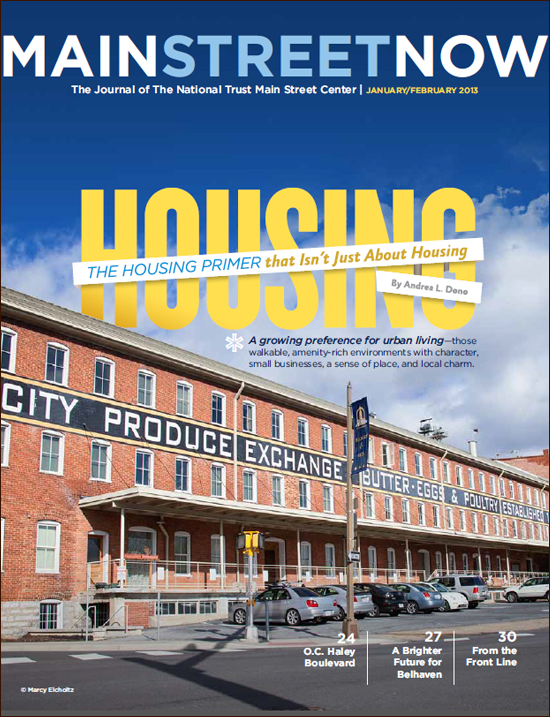 Downtown Harrisonburg has seen some major growth over the past eight years and there are exciting projects on the horizon. Perhaps that's why Downtown Harrisonburg was recently featured in the national publication pictured above, Main Street Now. In fact, the magazine actually features a lengthy case study highlighting the successes in downtown Harrisonburg, with quotes from Eddie Bumbaugh, Barry Kelley, Andrew Forward and John Sallah.... 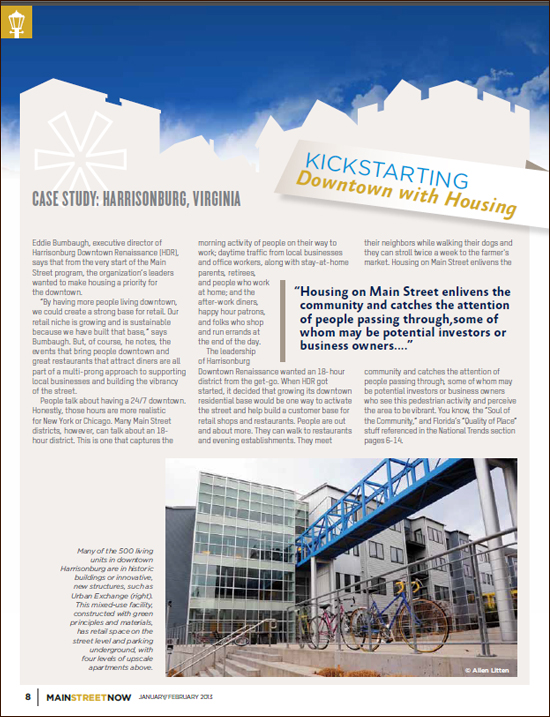 Click here to download the Jan/Feb 2013 issue of Main Street Now to read the full story about how Downtown Harrisonburg has been transformed in recent years. | |
THE ICE HOUSE, an innovative mixed-use redevelopment project in Downtown Harrisonburg is officially underway |
|
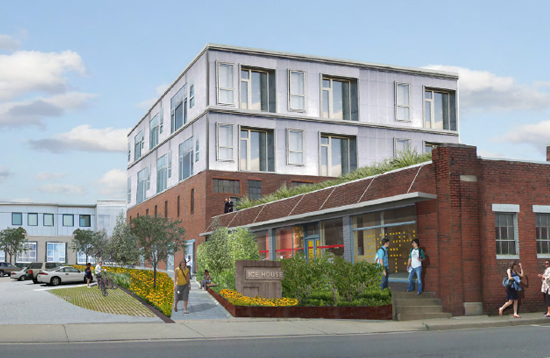    Local developers, Barry Kelley and Andrew Forward, are at it again -- transforming a downtown structure into an inspiring new space. Some of Barry and Andrew's past projects include City Exchange, Urban Exchange and The Walton Hotel. VISION - Some of the ideas that have been discussed for The Ice House include:
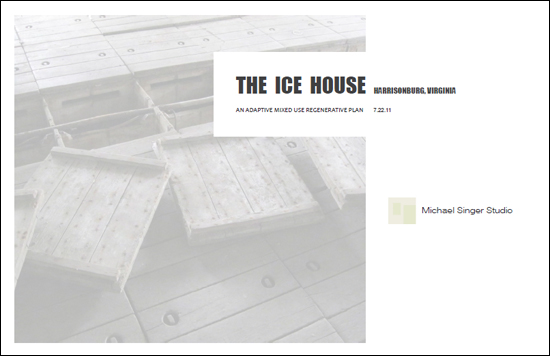 LOCATION - The Ice House will be a transformation of the former Cassco ice plant located at 217 S. Liberty Street. As you can see, it's not a very exciting sight right now.... 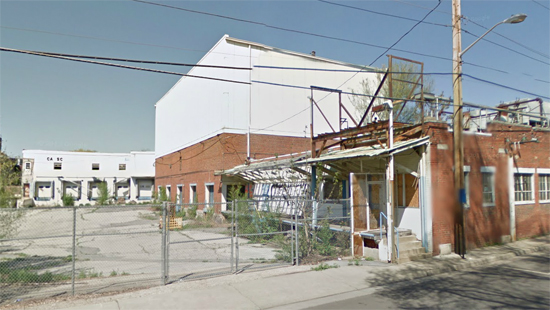 ZONING - The City of Harrisonburg has approved a rezoning request for 217 S. Liberty Street and the adjacent building, 115 W. Bruce Street. HISTORICAL TAX CREDITS; GRANT - One of the only reasons that this project is able to move forward is because of the historical tax credits available for the project. INDUSTRIAL REVITALIZATION FUND GRANT - Harrisonburg received a $500,000 grant from the Virginia Department of Housing and Community Development's Industrial Revitalization Fund. This grant is effectively a low-cost loan that will be available for the development of The Ice House. COMMERCIAL TENANTS - Conversations are ongoing, but James Madison University has confirmed that they will occupy some of the space in The Ice House. One of the JMU offices that will relocate to The Ice House is communications, marketing and public affairs. Additional current plans for the commercial space include a restaurant, a mint operation and a yoga studio. SCOPE, TIMING - The transformation of this 80,000 square foot building is estimated to cost $10 million and the aim is to have it substantially complete by the end of 2014. STATUS - A detailed master plan is currently being developed to include 217 S. Liberty Street, 115 W. Bruce Street, as well as a 104-space parking lot on a parcel diagonally across West Bruce Street. 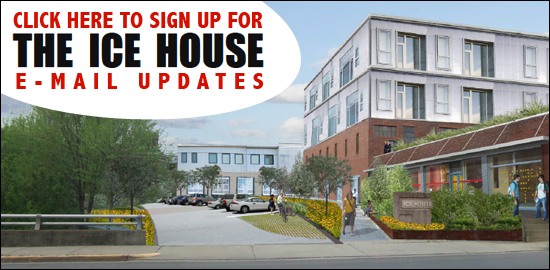 | |
New Urbanist Community, Collicello North, under development in Harrisonburg |
|
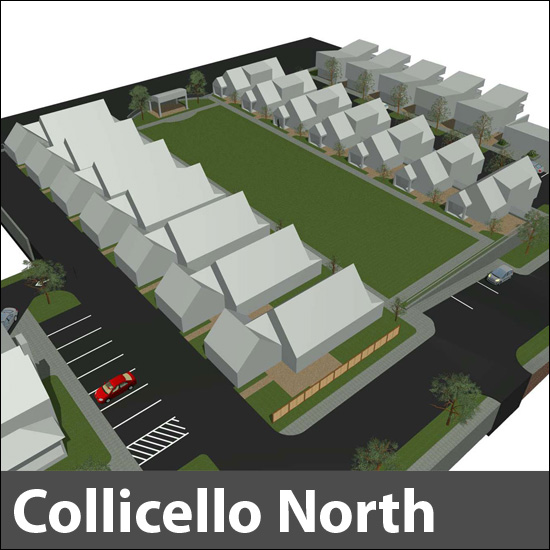 Collicello North is a new community being developed on the north end of Collicello Street (see map below) being developed as a smaller, more intimate and sustainable neighborhoods within walking distance of entertainment, recreation, shopping and public transportation. Dean Weavers of Blue Ridge Architects explains his vision for the community: Read more on the Blue Ridge Architects blog. 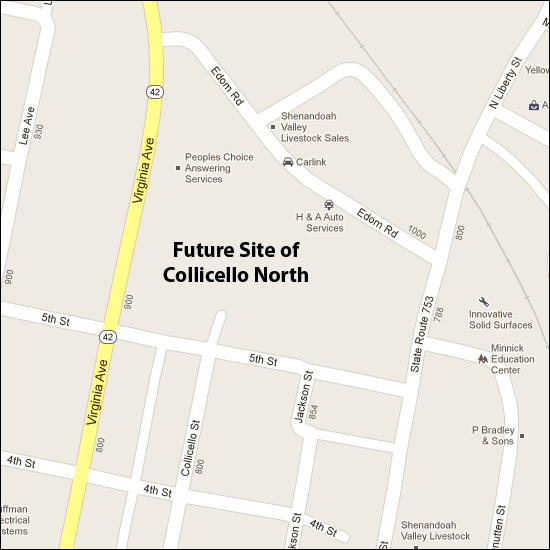 | |
New gated luxury community for JMU students on Port Republic Road? |
|
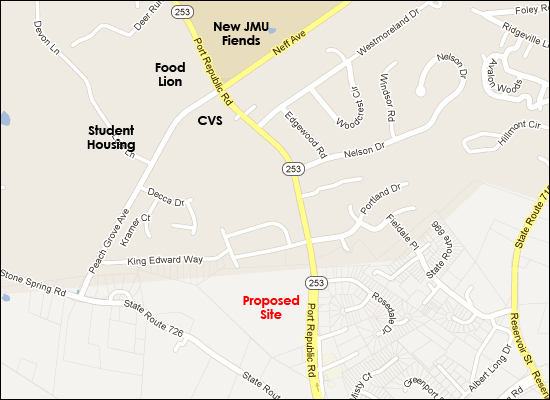 Aspen Heights LLC, is attempting to rezone a 23-acre parcel of land on Port Republic Road (shown above) for a gated, luxury community for students. The city has some doubts, per the Daily News Record article, which seem to include the current glut of student housing in Harrisonburg, as well as the surrounding largely owner occupied neighborhoods.  Some of the student housing developments that Aspen Heights, LLC has built (yes, the photo above is a student housing development) seem quite nice. View photos of their communities, their current locations, and what they believe sets them apart as a student housing community. This Tuesday there will be a Planning Commission meeting to discuss this potential rezoning. In other related student housing news, you'll notice some new student housing popping up on Stone Spring Road near the RMH Wellness Center. | |
Size Distribution of Rockingham County Land Parcels |
|
Rockingham County, Virginia (not including the City of Harrisonburg) is comprised of (approximately) 46,600 parcels of real estate. Some of these lots or tracts are very small, in towns such as Grottoes, Dayton or Elkton. Others are quite expansive and are in the far flung corners of the County. Below is a visual representation of the distribution of lot sizes of those 46,600 properties --- you might need to click on this link to view the full size document for easier reading. Here's the summary:
| |
Mayor Kai Degner on Harrisonburg's upcoming Mayor's Sustainability Summit |
|
Get up close and personal (thanks to unanticipated loud construction equipment) with Harrisonburg mayor Kai Degner, and hear about the upcoming Mayor's Sustainability Summit to be held in downtown Harrisonburg. As Kai mentioned, the agenda for the Summit will be formed around the interests and desires of those in attendance, but may likely include topics such as:
Mayor's Sustainability Summit Saturday, May 30, 2009 9:00 a.m. - 5:00 p.m. Starting and ending in Court Square Theater View more details by clicking here. | |
What is Smart Growth? |
|
From Wikipedia: "Smart growth is an urban planning and transportation theory that concentrates growth in the center of a city to avoid urban sprawl; and advocates compact, transit-oriented, walkable, bicycle-friendly land use, including neighborhood schools, complete streets, mixed-use development with a range of housing choices. Smart growth values long-range, regional considerations of sustainability over a short-term focus. Its goals are to achieve a unique sense of community and place; expand the range of transportation, employment, and housing choices; equitably distribute the costs and benefits of development; preserve and enhance natural and cultural resources; and promote public health." To summarize, Smart Growth is building in the right place:
Additional Smart Growth resources:
| |
Is Growth Good Or Evil? |
|
 Well, perhaps we don't have to narrow it down with such extreme labels, but there has been some interesting debate over the subject over at hburgnews.com, all of which began with the issue of funding disappearing for the expansion of Port Republic Road. Here are some of my thoughts, though I would love to hear other perspectives on the subject: WHY GROWTH OCCURS: Desirable area -> people want to live here -> they need a place to live -> many want to buy -> more homes are needed -> land is rezoned -> lots are developed -> houses are built. While growth stems from a positive situation (an area being desirable), it is also true that:
But what is the alternative? To halt growth? To do so, a locality would need to either:
Taking either of these steps would (in my opinion) have some rather negative consequences:
| |
Will Rockingham County Be Paved Over? |
|
I have heard some people talk about development as if in the next few years, or decades, all of Rockingham County will be developed --- with the farm land destroyed, and our history no longer preserved. Below I'll try to put that thought in the context of actual land use, but for the record --- I don't think many at today's Smart Growth Symposium thought that the above statement is true. (Lest anyone conclude that I am referring to any of the attendees). 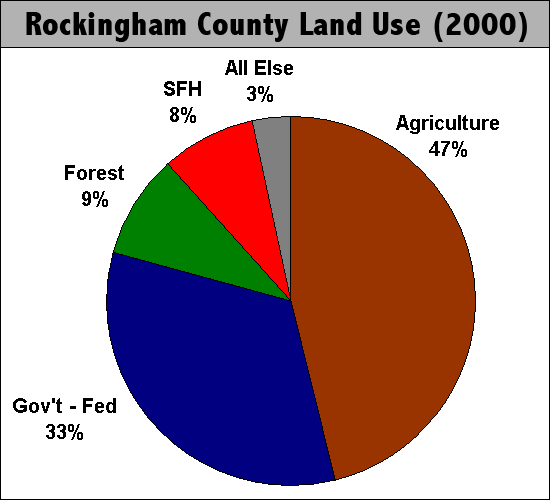 The data above is extracted from the Rockingham County Comprehensive Plan, particularly page 18 of the section on Strategies, Policies and Actions. Here's the full list of how Rockingham County land is being used:
| |
Smart(er) Growth For Harrisonburg and Rockingham County? |
|
Wow! Today's Smart Growth Symposium, orchestrated by the Shenandoah Valley Builders Association was a fantastic primer on growth issues and how to plan for them in the central Shenandoah Valley. Stewart Schwartz, the Executive Director of the Coalition for Smarter Growth, provided a great overview of smart growth principles and policies that provided a helpful framework for thinking about and planning for the future of our area. One key point that he made, that stuck with me, was a need to focus on developing in the right place. Those present included conservationists, builders, farmers, real estate agents, bankers, local planning staff, elected officials, engaged citizens, and more. There seemed to be a great desire for and capacity to consider working together for the best future for our valley, despite the varying perspectives each of us bring to the table. | |
Builders Association To Hold Smart Growth Symposium |
|
The Shenandoah Valley Builders Association will hold a Smart Growth Symposium on Friday, February 22, with registration at 9:30 AM and finishing around 3:30 PM. This event will be an opportunity for members of the community to come together to learn about issues related to growth from a variety of perspectives, and to participate in a public conversation on the future of the Shenandoah Valley. The schedule of speakers and topics is as follows: 10:00 AM - Stewart Schwartz, Coalition for Smarter Growth Addressing the topic, "The Smart Growth Option" 11:45 AM - Lunch served 12:30 PM - Question & Answer session for panel of guests:
Addressing the topic "What is a Comprehensive Plan?" This should be an informative day with a variety of opinions and perspectives. The cost is $10 per person and includes lunch, and the deadline to RSVP is by Wednesday, February 20. Reservations and payment can be made online. | |
Scott Rogers
Funkhouser Real
Estate Group
540-578-0102
scott@funkhousergroup.com
Licensed in the
Commonwealth of Virginia
Home Search
Housing Market Report
Harrisonburg Townhouses
Walk Through This Home
Investment Properties
Harrisonburg Foreclosures
Property Transfers
New Listings

